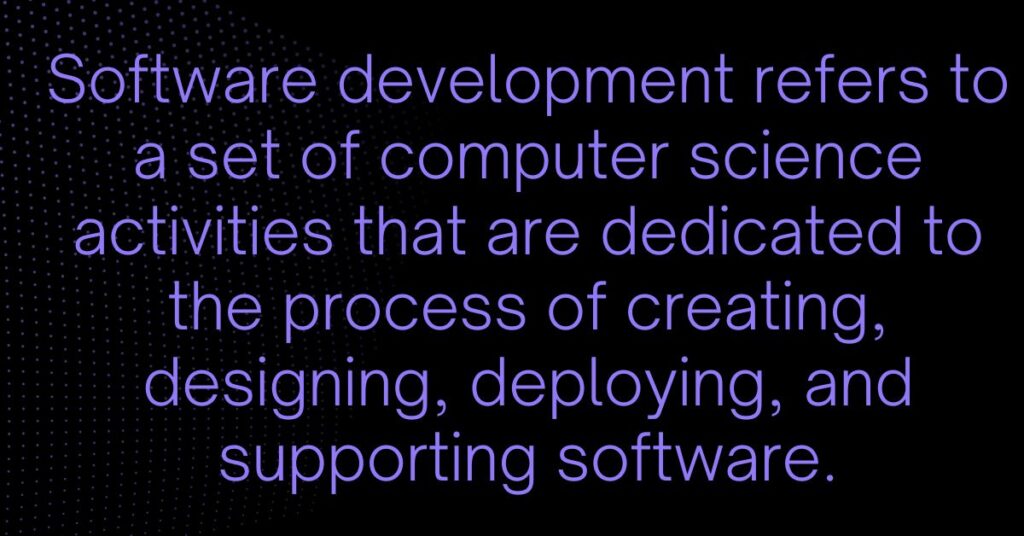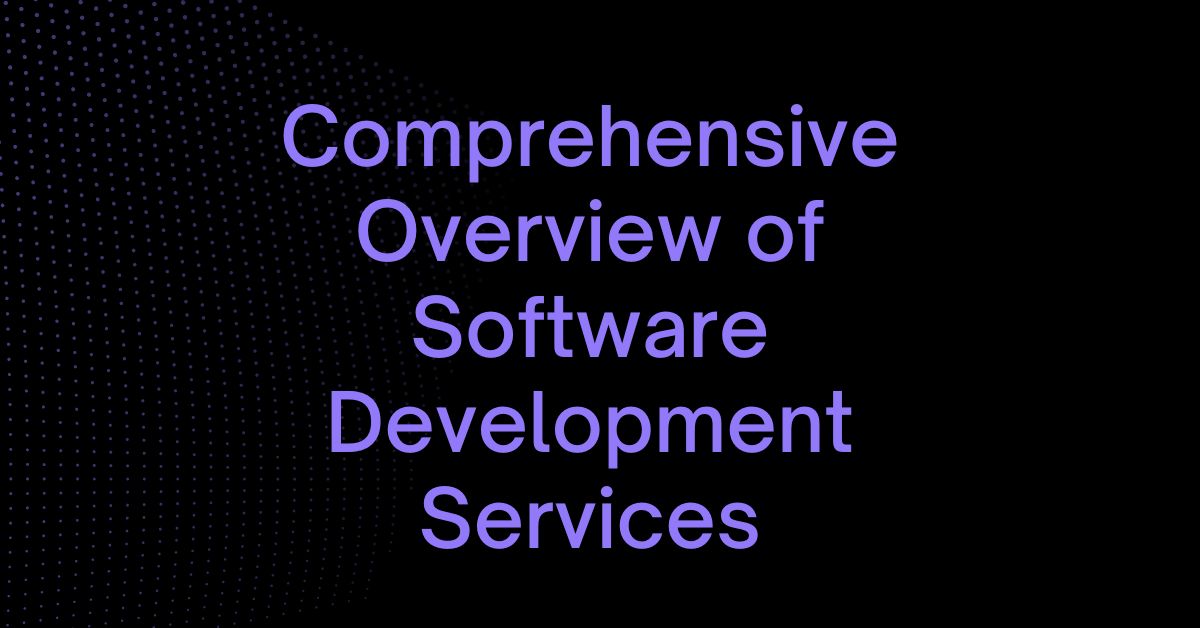In today’s digital age, businesses rely heavily on technology to streamline operations, improve customer experiences, and remain competitive. At the heart of this technological transformation lies software development services—an essential component for organizations across industries to innovate and meet their goals. Whether it’s a start-up launching a mobile app, a mid-size business looking to improve internal processes, or a large enterprise implementing an enterprise-wide software system, software development services offer tailored solutions that align with business objectives.
This article provides an in-depth exploration of software development services, outlining the types, stages, methodologies, benefits, and how to select the right service provider.
What Are Software Development Services?

Software development services involve the design, creation, deployment, and maintenance of software applications tailored to the unique needs of an organization. These services encompass a wide range of activities from conceptualizing software solutions to post-launch support. While the scope of services can vary based on the specific business goals and industry needs, they generally fall into the following categories:
1. Custom Software Development
Custom software is developed specifically to address the unique needs of a business. Unlike off-the-shelf solutions, custom software is tailored to specific requirements, providing better control, flexibility, and scalability. From CRM systems to inventory management tools, custom software can be designed to integrate seamlessly with existing infrastructure and scale as the business grows.
2. Web Application Development
Web applications are interactive software tools accessed through a web browser. These applications can range from simple websites to complex online platforms like e-commerce stores, social networking platforms, and SaaS (Software as a Service) products. Web application development focuses on building responsive, secure, and scalable solutions that deliver great user experiences across different devices.
3. Mobile Application Development
Mobile app development involves creating software applications specifically for mobile devices, such as smartphones and tablets. These apps can be developed for different platforms like Android, iOS, or cross-platform using technologies like React Native or Flutter. Mobile applications are essential for businesses aiming to connect with customers on the go, providing them with streamlined and efficient access to services.
4. Enterprise Software Development
Enterprise software refers to solutions that cater to the needs of large organizations. These solutions include ERP (Enterprise Resource Planning), SCM (Supply Chain Management), and CRM (Customer Relationship Management) systems. Enterprise software development focuses on integrating these solutions across departments and ensuring they meet the company’s large-scale operational requirements.
5. Software Integration Services
As businesses adopt various software solutions over time, ensuring seamless communication and integration between these systems becomes crucial. Software integration services involve developing APIs (Application Programming Interfaces) and middleware that allow different software tools to work together, improving efficiency and reducing operational silos.
6. Software Testing and Quality Assurance
Software testing and quality assurance (QA) are critical components of the software development lifecycle. QA ensures that the software meets the required standards and functions as expected. Software testing involves identifying bugs, security vulnerabilities, performance issues, and other potential flaws before the software goes live.
7. Maintenance and Support
After deploying a software application, continuous monitoring, maintenance, and updates are necessary to keep it secure, functional, and efficient. Maintenance services include bug fixing, performance optimization, security patches, and feature enhancements based on user feedback and technological advancements.
The Software Development Process
Software development is a structured process that typically follows a series of stages. These stages ensure that the software is designed, developed, and deployed efficiently while meeting the business objectives and user needs. The process is often referred to as the software development life cycle (SDLC) and consists of the following key phases:
1. Requirement Analysis
The first stage involves gathering and analyzing business requirements to understand what the software needs to accomplish. This stage includes meetings with stakeholders, users, and project managers to determine the project’s scope, goals, functionality, and technical specifications.
2. Planning
Once the requirements are clear, the next step is planning the development process. This includes defining the project timeline, resources, budget, and milestones. A well-structured plan ensures that the project progresses smoothly and is delivered on time and within budget.
3. Design
During the design phase, the software’s architecture, user interfaces, and technical infrastructure are developed. This stage involves creating wireframes, user interface mockups, database designs, and the overall system architecture. The design phase is crucial in ensuring that the software will be user-friendly, scalable, and maintainable.
4. Development
This is the phase where the actual coding and development of the software take place. Developers create the software according to the specifications laid out in the design phase. During development, the software is broken down into smaller modules, which are coded, tested, and integrated into the larger system.
5. Testing
Before the software is launched, it undergoes rigorous testing to identify any bugs, performance issues, or security vulnerabilities. This stage includes various types of testing, such as unit testing, integration testing, system testing, and user acceptance testing. Quality assurance teams work closely with developers to ensure the software meets the required standards.
6. Deployment
Once the software passes all tests, it is deployed into the production environment. The deployment process involves installing, configuring, and making the software available to users. Depending on the complexity of the project, deployment can be done in phases or all at once.
7. Maintenance
After deployment, the software enters the maintenance phase, where it is continuously monitored for bugs, performance, and security. Regular updates and improvements are made to ensure that the software continues to meet user needs and adapts to new technological trends.
Software Development Methodologies
Software development methodologies provide frameworks for how the development process should be carried out. Different methodologies emphasize various aspects of the development process, such as speed, flexibility, or structure. Here are some of the most commonly used software development methodologies:
1. Waterfall Methodology
The Waterfall model is a linear and sequential approach to software development. Each phase (e.g., planning, design, development, testing, deployment) is completed before moving on to the next. This methodology is best suited for projects with well-defined requirements and minimal expected changes.
2. Agile Methodology
Agile is a flexible and iterative approach that focuses on delivering small, functional parts of the software (called sprints) over short timeframes. Agile methodologies emphasize collaboration, adaptability, and continuous feedback, allowing teams to respond to changes quickly. Agile is widely used in today’s fast-paced software development environment, especially for projects with evolving requirements.
3. Scrum
Scrum is a subset of Agile and focuses on managing projects through short development cycles called sprints, usually lasting two to four weeks. Scrum teams have specific roles, such as the product owner, scrum master, and development team. Scrum promotes daily stand-up meetings, sprint reviews, and retrospectives to ensure continuous improvement.
4. DevOps
DevOps is a methodology that integrates software development (Dev) and IT operations (Ops) to improve collaboration between teams. It focuses on automating and streamlining the development and deployment processes to enhance speed, quality, and reliability. DevOps emphasizes continuous integration, continuous deployment (CI/CD), and real-time monitoring of software systems.
5. Lean Development
Lean software development focuses on delivering value to the customer while minimizing waste in the development process. Lean principles include optimizing resources, enhancing efficiency, and delivering quality software quickly. This methodology is ideal for organizations that want to reduce development time and costs.
Benefits of Software Development Services
Software development services offer a wide range of benefits to organizations of all sizes. These advantages extend across industries and can drive significant improvements in business processes, customer engagement, and operational efficiency.
1. Customization
Custom software development allows businesses to build solutions that are tailored to their specific needs. This flexibility means that the software can evolve alongside the business, adapting to new requirements and challenges.
2. Improved Efficiency
Automating tasks and streamlining workflows through software solutions can significantly improve business efficiency. Custom-built software can reduce manual errors, speed up processes, and ensure better use of resources.
3. Scalability
As businesses grow, their software needs often become more complex. Scalable software solutions can grow with the business, accommodating an increased workload, new users, and additional functionality without compromising performance.
4. Cost Savings
Though custom software development may involve an upfront investment, it can save businesses money in the long run by reducing the need for multiple off-the-shelf solutions. Well-developed software can also lower operational costs by improving productivity and automating repetitive tasks.
5. Competitive Advantage
Tailored software solutions can provide businesses with a competitive edge by offering unique functionalities that differentiate them from competitors. Whether it’s a superior customer experience or enhanced internal processes, custom software can help a business stand out in the marketplace.
6. Security
Custom software development can focus on building highly secure systems that meet industry-specific regulations and compliance requirements. Unlike off-the-shelf software, which may have vulnerabilities known to hackers, custom software is less exposed to common threats and can be designed with advanced security features.
Choosing the Right Software Development Service Provider
Selecting the right software development service provider is a crucial decision that can determine the success of a software project. Here are key factors to consider when choosing a provider:
1. Experience and Expertise
Look for a provider with a proven track record in delivering similar projects. A company’s experience in your industry can ensure that they understand your specific challenges and requirements.
2. Technical Skills
Ensure that the development team has the necessary technical expertise in the technologies you require, whether it’s front-end frameworks, back-end languages, mobile development platforms, or cloud services.
3. Communication and Collaboration
Clear and frequent communication is essential for the success
of any software development project. Choose a provider that offers transparency, regular updates, and collaborative tools to ensure the project stays on track.
4. Cost and Budget
Understand the provider’s pricing model and ensure it aligns with your budget. Be cautious of overly low estimates, as they may lead to compromised quality or hidden costs down the road.
5. Post-Development Support
A reliable software development provider will offer post-launch support, including maintenance, bug fixing, and feature updates. Ensure the provider has a plan for ongoing support after the initial development phase.
Conclusion
Software development services are the backbone of digital transformation for businesses. Whether you’re looking to build a custom solution, integrate software systems, or improve efficiency, software development services can help you achieve your business goals. By understanding the types of services available, the development process, and the methodologies that drive success, businesses can make informed decisions when embarking on a software development project. Selecting the right service provider, aligning the project with business objectives, and leveraging the benefits of custom software solutions can lead to long-term success in today’s technology-driven world.
